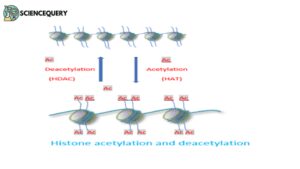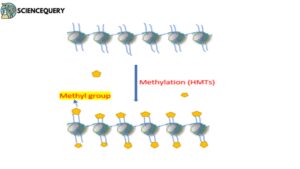
Know in one minute about histone
|
Introduction
Histones are positively charged, alkaline proteins, responsible for the packaging of DNA and form the structural unit called nucleosomes. These proteins condense to form chromatin.
Hence, they plays an important role in the formation of nucleosomes and chromatin.
Definition
In eukaryotes, there is a set of positively charged, alkaline proteins found in the nucleus called histone. They are rich in positively charged amino acids such as lysine and arginine. These proteins are organized to form a unit of eight molecules called histone octamer.
Structure of histone
- Histone proteins are arranged in two parts. In one part eight molecules of H₂A, H₂B, H₃, and H₄ are present, while in the second part H₁ is present.
- H₂A, H₂B, H₃, and H₄ are the heterodimers, each heterodimer is attached with 30bp (base pairs) long DNA which contacts at 10 bp intervals.
- The core particle is octamer. It is made up of two tetramer molecules of H₂A, H₂B, H₃, and H₄.
- The core particle is a wedge-shaped (from one side it is thick while thin on the other side) structure with a diameter of 11nm and height of 6nm.
- The coiled molecule of DNA is wrapped around its middle part and forms a supercoil.
The long amino-terminal tail of histone molecules without secondary structure are arranged in a sequence, to help in the interaction of one nucleosome with another nucleosome.
Functions of histones
- Histone proteins are highly alkaline basic proteins and positively charged, linked with negatively charged phosphate groups of DNA, and help in the packaging/folding of DNA. Hence it forms a small platform for wrapping DNA.
- Helps to give structure to the chromosomes.
- Plays an important role in regulating gene expression and in DNA modification.
- The high regulation structure of core particles helps in determining the structure of chromatin.
Acetylation of histone

Histone acetylation is a process that involves the covalent addition of an acetyl group to lysine residues in the protruding histone tails. It is usually associated with transcriptional activation and is
modulated by histone acetyltransferases (HATs) which are responsible for adding acetyl groups and histone deacetylases (HDACs) which remove them.
Acetylation removes the positive charge of the histone tail, reducing affinity for the negatively charged phosphate groups of DNA. It also reduces the affinity of the tail for adjacent nucleosomes, thus affecting the ability of the nucleosome array to form a more repressive higher-order chromatin structure.
Methylation of histone

It is the introduction of a methyl functional group to lysine or arginine of the histone tail. These reactions are catalyzed by enzymes with histone methyltransferase (HMTs). Methylation does not neutralize charge but recruits silencing or regulatory proteins that bind methylated histones. Methylation may result in the activation or repression of gene expression.
Q&A
1. What are histone?
Histones are a special group of proteins found in the nuclei of eukaryotic cells. Histone proteins are highly alkaline basic proteins and positively charged, linked with negatively charged phosphate groups of DNA.
There are two main classes of
Core and linker histones
1. Core histone
Core histone includes H₂A, H₂B, H₃ and H₄. H₂A and H₂B contain more lysine while H₃ and H₄ contain more arginine Two of each of these core histone proteins assembles to form one octameric nucleosome core particle.
2. Linker histone
Linker histones including H₁ and H₅ both contain the highest lysine/arginine ratio.H1 binds the nucleosomes at the starting and ending site of the DNA, thus locking the DNA into place and help in the formation of higher-order structure.H5 histones involved in the packaging of a specific region of DNA.
2. Why do histones bind to tightly to DNA?
Histones are a special group of proteins found in the nuclei of eukaryotic cells responsible for DNA folding and chromatin formation Their proteins are highly alkaline basic proteins and positively charged, linked with negatively charged phosphate groups of DNA. DNA is negatively charged, due to the phosphate group In its phosphate-sugar backbone therefore, they binds with DNA very tightly.
3. Which of the following molecular characteristics cause histones to bind tightly to DNA?
Histone belongs to a family of highly basic proteins whose primary job is to associate with DNA and condense the chromatin. Histones are rich in positively charged amino acids such as lysine and arginine. They are alkaline or basic pH proteins, and their positive charge allows them to associate with the negatively charged DNA with great affinity.
Written By: Neetu Ladiya
Reference
Zoology-Second year by V.K. Tiwari and V.K. Singh (Shiva lal agrawal and company)
